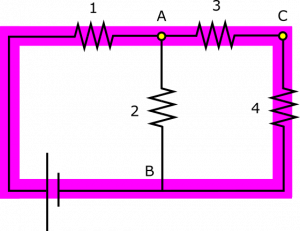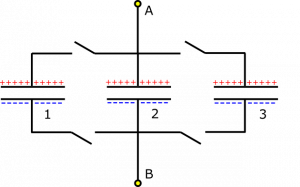This is an old revision of the document!
Connecting Already-Charged Capacitors
Suppose you have the following setup of already-charged capacitors. The positive plates are all on the top half of the circuit. Capacitors are labeled 1 through 3 for convenience of reference, and the sign of the charge on the plates is indicated. You know that Q1=Q2=Q3=1 mC, and ΔV1=ΔV2=ΔV3=20 V. What is the equivalent capacitance (if the switches are closed) from Node A to Node B? What happens after the switches are closed? What if Capacitor 2 were flipped?
Facts
- Q1=Q2=Q3=1 mC
- ΔV1=ΔV2=ΔV3=20 V
- Capacitors are aligned as shown in picture.
- Capacitor 2 is flipped in the second case.
Lacking
- Cequiv
- Explanations for what happens after the switches are closed, in both cases.
Approximations & Assumptions
- The potential differences across the segments of wire are very very small in comparison to the potential differences across the capacitors.
Representations
- We represent capacitance as C=QΔV
- We represent the Loop Rule (for potential difference within a closed loop) as
ΔV1+ΔV2+ΔV3+…=0
- We represent the equivalent capacitance of multiple capacitors arranged in parallel as
Cequiv=C1+C2+C3+…
- We represent the situation with diagram given above. The flipped situation is below.
Solution
Let's start with resistance. The equivalent resistance for the entire circuit can be found with Ohm's Law – equation (1): Requiv, circuit=ΔVbatteryI1=240Ω
We use I1 since this is the current in the wire connected directly to the battery. We can break this down further to find the equivalent resistance in the chunk of the circuit containing Resistors 2, 3, and 4. This chunk and Resistor 1 are connected in series to form the resistance of the whole circuit, so we can use equation (2) to write: Requiv, circuit=R1+Requiv, chunk with 2,3,4 This yields Requiv, chunk with 2,3,4=160Ω.
Notice that this “chunk” is actually two parallel pieces of the circuit, starting at Node A and ending at Node B. The two parallel parts are Resistor 2, and then Resistors 3 and 4 together. We can use equation (3) to break down the chunk into these two pieces (we combine Resistors 3 and 4 below using equation (2)): 1Requiv, chunk with 2,3,4=1R2+1R3+R4 We can plug in what we know and solve for the resistance of Resistor 2: R2=200Ω
Okay, now for the potential differences. It will be useful in the approach we choose to know the current through Resistor 4, which is found from Ohm's Law: I4=ΔV4R4=10 mA A simple application of Node Rule – equation (5) – at Node C should tell us that I3=I4. Now, we can reapply Ohm's Law to find the potential difference across Resistor 3: ΔV3=I3R3=I4R3=3 V
 A couple applications of the Loop Rule should help us find the rest of the unknowns. Consider the loop highlighted in the circuit above. The Loop Rule – equation (4) – tells us that if we travel completely around the loop, we should encounter a total potential difference of 0. If we travel along the direction of conventional current (clockwise in our representation), voltage decreases, so ΔV1, ΔV3, ΔV4<0, whereas we have ΔVbat>0. These four potential differences form a loop, so they should add to 0:
ΔVbat−ΔV1−ΔV3−ΔV4=0
We know enough potential differences to find the voltage across Resistor 1:
ΔV1=ΔVbat−ΔV3−ΔV4=4 V
A couple applications of the Loop Rule should help us find the rest of the unknowns. Consider the loop highlighted in the circuit above. The Loop Rule – equation (4) – tells us that if we travel completely around the loop, we should encounter a total potential difference of 0. If we travel along the direction of conventional current (clockwise in our representation), voltage decreases, so ΔV1, ΔV3, ΔV4<0, whereas we have ΔVbat>0. These four potential differences form a loop, so they should add to 0:
ΔVbat−ΔV1−ΔV3−ΔV4=0
We know enough potential differences to find the voltage across Resistor 1:
ΔV1=ΔVbat−ΔV3−ΔV4=4 V
 Now, consider the (different!) loop highlighted in the circuit above. The Loop Rule tells us that if we travel completely around the loop, we should encounter a total potential difference of 0. We see that current in Resistor 2 runs opposite to the current in the other resistors if we follow the loop in one direction. We have to choose a direction for the application of the Loop Rule. If we go clockwise, voltage increases across Resistor 2, but drops across Resistors 3 and 4. So we write:
ΔV2−ΔV3−ΔV4=0
We know enough potential differences to find the voltage across Resistor 2:
ΔV2=ΔV3+ΔV4=8 V
That's all! Note that there are a lot of ways to do this problem, but we chose an approach that showcases the power of knowing equivalent resistance for resistors in parallel, and the power of the Loop Rule. See if you can create a different method for finding the unknowns.
Now, consider the (different!) loop highlighted in the circuit above. The Loop Rule tells us that if we travel completely around the loop, we should encounter a total potential difference of 0. We see that current in Resistor 2 runs opposite to the current in the other resistors if we follow the loop in one direction. We have to choose a direction for the application of the Loop Rule. If we go clockwise, voltage increases across Resistor 2, but drops across Resistors 3 and 4. So we write:
ΔV2−ΔV3−ΔV4=0
We know enough potential differences to find the voltage across Resistor 2:
ΔV2=ΔV3+ΔV4=8 V
That's all! Note that there are a lot of ways to do this problem, but we chose an approach that showcases the power of knowing equivalent resistance for resistors in parallel, and the power of the Loop Rule. See if you can create a different method for finding the unknowns.

